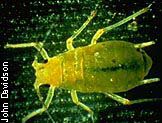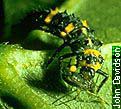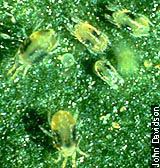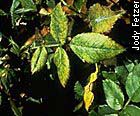
Photo 11: Aphid.
| Aphids | (Rose aphid, Macrosiphum rosae; Potato aphid, Macrosiphum euphorbiae) |
Identification
 Photo 11: Aphid. |
Scouting
Aphids feed by sucking plant juices, causing distortion of young leaves and stunting new growth. Flowers may also be affected when aphids feed on the buds. watch for honeydew, a clear, shiny, sticky waste product that collects on the leaves below the aphids and attracts ants. A black fungus called sooty mold also grows on the honeydew.
 Photo 12: Ladybird beetle larva eating an aphid. |
 Photo 13: Parasitic wasp emerged from mummified aphid. |
Control
While they have many natural predators and parasites, aphid populations can increase rapidly. Spraying with water can dislodge aphids. Do this early enough so that leaves dry by sunset. Biorational insecticides such as insecticidal soap are effective on aphids. Since insecticidal soaps work well on aphids and have low toxicity, they are suggested over conventional insecticides. Insecticidal soaps must contact the aphids directly. Conventional insecticides for aphids include pyrethrins, malathion, acephate (Orthene),
and chlorpyrifos (Dursban). A long-term strategy is to add beneficial insects (such as ladybird beetles or lacewings) to the area, though it can be difficult to get good control of the aphids. Feeding ladybird beetles honey before release can improve their retention on the plant.
Twospotted spider mites (Tetranychus urticae)
 Photo 14: Twospotted spider mites. |
Scouting
Mites feed by sucking plant juices out of individual cells from a wide variety of ornamental plants including roses. This causes small yellowish stippling (like spray paint droplets) on the foliage of host plants. Also look for very fine webbing on leaves and stems. As a result of heavy mite populations, leaves may turn yellow and drop from the plant. You can also check for mites by shaking branches over a white sheet of paper. The mites show up as tiny moving specks.
 Photo 15: Twospotted spider mite damage. Notice bleaching of color in leaf. |
| HOME: Insect Pests of Roses | NEXT: Bud/shoot feeders |